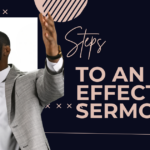As an Amazon Associate I earn from qualifying purchases.
At the end of one of my sermons, someone told me that the sermon eliminated the distance between the Bible world and today’s world. When this happens, you have done your job in a very real way. To do this, the preacher must help the people to understand and experience the Bible world. And to push it a little further, the people must understand and experience the implications of the Bible world in today’s world.
The Lecture Trap
If the people are to know and experience the Bible world in today’s world, then they must first of all know the Bible world. It is our job as preachers to give people enough knowledge of the Bible world so that they can understand it. This is more difficult job today than in the past. In the past, we could assume that people knew the great stories of the Bible. They knew who Moses was. They knew who Adam Was. They knew about the great fish that ate Jonah. They knew about the Valley of Dry Bones. They knew about John the Baptist. In short, they knew a lot of these stories that provided a backdrop for our preaching.
However, we can no longer assume that people know these stories, let alone understand them. Because of this we must have a pedagogical move in many of our sermons. We must teach these stories, and we must help the people to catch a glimpse of some of the implications.
Now some have heard of this and have turned sermons into lectures on Biblical topics. The people learn about the Bible world, but they never experience it nor move it into today’s world. Some “expository” preachers fall into this trap. (By no means do all “expository” preachers make this mistake. A good book that helps the preacher keep from turning the sermon into a lecture from the evangelical side is by Bryan Chapel Christ Centered Preaching.)
Simply put, helping people Understand the scripture in its native Bible World is not enough. We must help people to Experience it.
Experiencing the Bible World
Have you seen the story? Do you smell the details of the story? Do you feel the texture of the story? For example, when the Prodigal Son was leaving home. Do you feel the anticipation in him? Do you see the glitter of a new world bouncing off of his eyes? Do you feel his exhilarated freedom? And then in the pig pen, do you smell the stink? Do you see and taste the slop that the son was reduced to eating? And then on the way home. Do you feel the fear that his father may not take him back. Do you see the same sites that caused him to be excited on the way now repelling him on the way back home?
If you can’t see, feel, taste, and hear the Bible story, then it is time to go back into it and read closer. In short, the people will not experience the scripture story until you have experienced it. Click Here to find more information on this kind of exegesis.
The people must be led to experiencing the text just like they need to know the text, but then that is still not enough in my opinion. Next we must move the people to Experiencing the implications of the text.
Experiencing the Implications of the Bible Story
It is here that people are changed. For it is one thing to know about what happened to the prodigal son, it is another thing to know what is happening to us in our daily lives. It is this step that eliminates the distance between the Bible story and our contemporary story. It is this step that opens the door for the Spirit to do to us and for us what was done to and for the Bible characters.
Here the preacher must provide enough context in the contemporary world to show its correspondence to the Biblical world described. When these two worlds are placed together, then the Bible story world becomes the world of the people. They can rejoice with the Hebrews who go through the Red Sea, because they are going through the Red Sea. They can identify with the trials of John who died in a prison, but will one day be called forth from the grave. This is the step that makes the Bible story our Story. It is this, I believe, that has helped African American preachers to preach in such a way that the people could keep their sanity through “many dangers, trials, and snares.” And it is this kind of preaching that will “take us home.”
Henry Mitchell’s book Celebration and Experience in Preaching is an important book that will help you to gain this mindset in your preaching.
Amazon and the Amazon logo are trademarks of Amazon.com, Inc, or its affiliates.


This is a big help to me. I am constantly trying to make the Bible real to the people in the pews, and this article has pointed out one area I was failing in. That will change with the next sermon.
I definitely agree with this article. This website in general is a huge help to my ministry. I would like to add that I feel our job as teachers and preachers is tougher because of the generation that we are living in. When I was a child I learned about Moses and all the great bible stories from going to Sunday School. Children arent going to or being taken to Sunday School. For me it was a requirement. I didn’t like it sometimes but now I’m glad I was made to go. Now we preach to the majority of children and young adults who have little to no biblical background therefore a teach/preach method is all but necessary. Thank you for this article God bless.